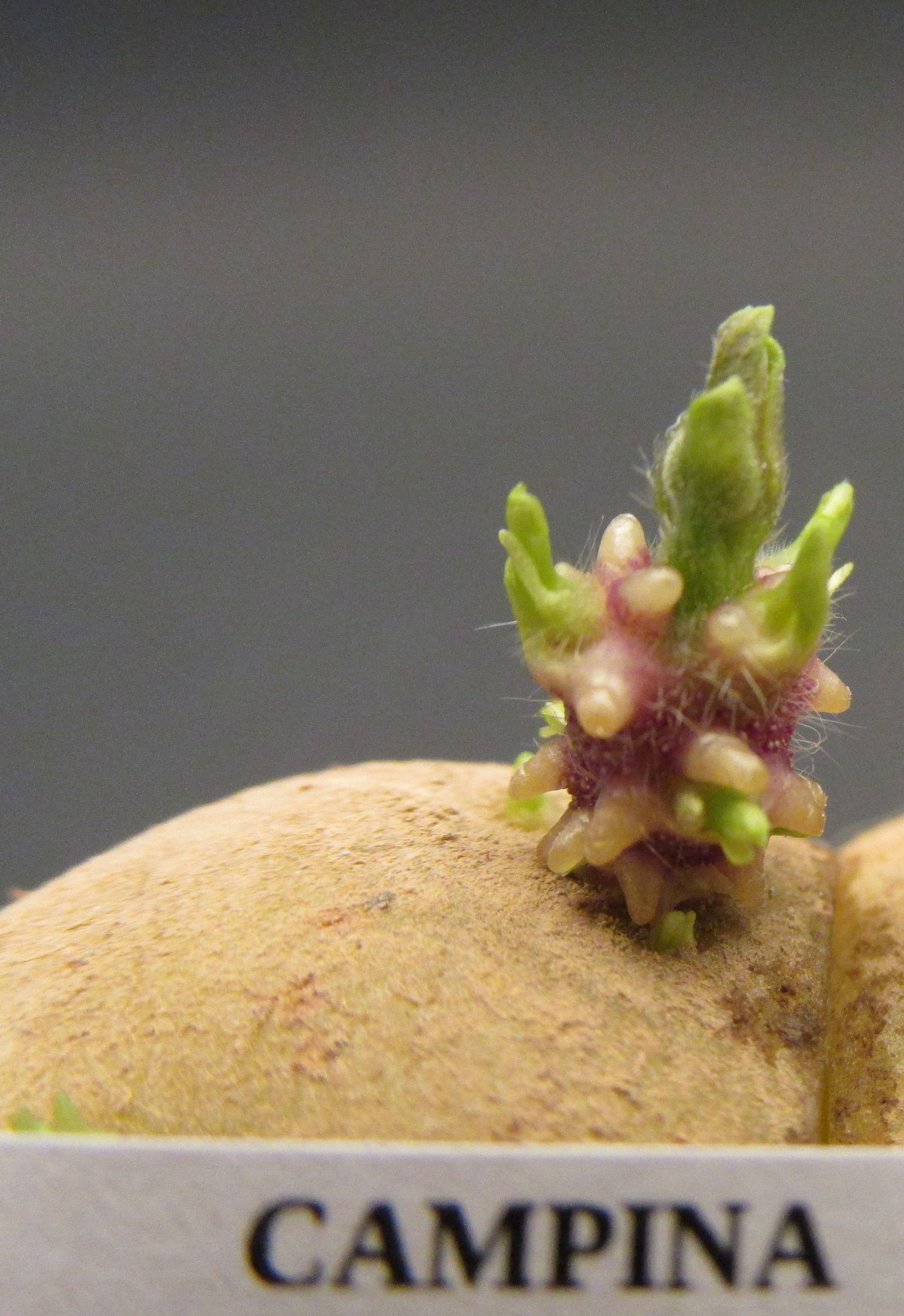Campina
| Denomination: | 'Campina' |
|---|---|
| Botanical Name: | Solanum tuberosum |
| Applicant/Holder: |
SaKa Pflanzenzucht GmbH & Co. KG Albert-Einstein- Ring 5 22761 Hamburg Germany |
| Breeder: |
Gunther Stiewe, SaKa Pflanzenzucht GmbH & Co. KG, Hamburg, Germany |
| Agent in Canada: |
Global Agri Services Inc. 376 New Maryland Highway New Maryland, New Brunswick E3C 1E5 Canada Tel: 506-462-9493 |
| Application Date: | 2012-11-06 |
| Application Number: | 12-7789 |
| Date Withdrawn: | 2016-03-08 |
Variety Description
Variety used for comparison: 'Adora'
Summary: The lightsprout of 'Campina' is broad cylindrical in shape with sparse pubescence at the base whereas that of 'Adora' is ovoid in shape with medium to dense pubescence at the base. The lightsprout of 'Campina' has lateral shoots of medium length and a medium number to many root tips whereas the lightsprout of 'Adora´ has short lateral shoots and few root tips. The stem and upper side of the midrib of the leaf of 'Campina' have no anthocyanin colouration whereas the extent of anthocyanin colouration are low on the stem and midrib of the leaf of 'Adora'. 'Campina' has a high frequency of coalescence of the terminal and lateral leaflets whereas it is absent or very low in 'Adora'. The extent of anthocyanin colouration of the flower bud and peduncle is absent or very low for 'Campina' whereas the extent is high for 'Adora'. 'Campina' has small inflorescences whereas those of 'Adora' are of medium size. On the inner side of the corolla, the anthocyanin colouration is absent or of very low extent and is absent or of very weak intensity for 'Campina' whereas the anthocyanin colouration is of medium extent and intensity for 'Adora'. The tuber of 'Campina' is oval in shape with shallow eyes and light yellow flesh whereas the tuber of 'Adora' is long oval in shape with eyes at a medium depth and cream coloured flesh.
Description:
LIGHTSPROUT: medium size, broad cylindrical shape, root tips medium to many in number, medium length of lateral shoots
LIGHTSPROUT BASE: medium intensity of anthocyanin colouration, absent or low proportion of blue in anthocyanin colouration, sparse pubescence
LIGHTSPROUT TIP: small in relation to base, habit is closed to intermediate between closed and open, absent or very weak to weak intensity of anthocyanin colouration, sparse pubescence
PLANT: foliage structure is intermediate type between stem and leaf types where foliage is half open and stems are partly visible, upright growth habit, matures mid-season
STEM: no anthocyanin colouration
LEAF: outline is medium size, openness is intermediate between closed and open, medium green on upper side, no anthocyanin colouration on midrib of upper side, medium to strong presence of secondary leaflets, high frequency of coalescence of terminal and lateral leaflets
SECOND PAIR OF LATERAL LEAFLETS: medium size, leaflet is narrower than long
LEAFLET: weak to medium waviness of margin, shallow to medium depth of veins, medium glossiness of upper side, glabrous blade at apical rosette
INFLORESCENCE: medium frequency per plant, small
PEDUNCLE: absent or very low extent of anthocyanin colouration
FLOWER BUD: absent or very low extent of anthocyanin colouration
COROLLA: medium size, absent or very low extent and absent or very weak intensity of anthocyanin colouration on inner side, absent or low proportion of blue in anthocyanin colouration on inner side
TUBER: oval shape, light yellow flesh
TUBER EYE: shallow depth, yellow to red at base
TUBER SKIN: yellow, in reaction to light the intensity of anthocyanin colouration is absent or very weak
Origin & Breeding History: The variety 'Campina' originated from a cross made in 2002 between the selection designated '95-003-1' as the female parent and 'Filea' as the male parent at the Saka Pflanzenzucht private breeding station in Windeby, Schleswig-Holstein, Germany. Seed from the cross were sown in the greenhouse in 2003. The resulting tubers were harvested and planted in the field in the spring of 2004. One of the selected progeny was given the designation 'Campina'. Selection criteria were negative mass selection for agronomic characteristics and resistance to various diseases.
Tests & Trials: The comparative trial for 'Campina' was conducted during the growing season of 2014 in Drummond, New Brunswick. The trial consisted of a single row with 60 plants spaced 0.3 metres apart for each variety. The distance between rows within the trial was 0.9 metres. Observations and measurements were taken from 10 plants of each variety.
Click on image for larger view

Potato: 'Campina'
Click on image for larger view

Potato: Reference variety 'Adora'
- Date modified: